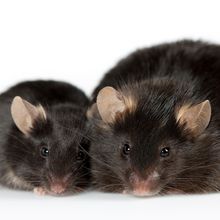Login
Subscribemouse model

Epigenetic Manipulations Can Accelerate or Reverse Aging in Mice
Alejandra Manjarrez, PhD | Jan 12, 2023 | 4 min read
Repairing damaged DNA appears to drive aging by causing the loss of epigenetic information, but restoring that information reverses such effects, a study finds.

Mucus-Eating Gut Bacteria May Promote Fever After Cancer Treatment
Alejandra Manjarrez, PhD | Jan 5, 2023 | 3 min read
The expansion of mucus-degraders in the mouse gut—possibly due to poor nutrition—thins the colon’s mucus layer and may weaken defenses against blood-infecting microbes.

LabTalk Podcast - A Modern Trojan Horse: Delivering Combination Immunotherapies to Solid Tumors
The Scientist and IsoPlexis | 1 min read
Katie McKenna discusses a combination CAR T and viral therapy that kills solid tumors.

Our Favorite Cancer Stories of 2022
Dan Robitzski | Dec 27, 2022 | 4 min read
This year, cancer researchers uncovered a variety of ways that tumors can survive and spread, ranging from damaging their own DNA to exploiting the nearby microenvironment for nutrients.

Specialized Sperm Ribosomes Are Key to Male Fertility in Mice
Dan Robitzski | Dec 15, 2022 | 4 min read
A previously unknown kind of ribosome is responsible for folding sperm proteins, which decay before fertilization if prepared by other ribosomes.

The Scientist Speaks Podcast - Episode 11
The Scientist | 1 min read
A Path Back to Health: Immune Tolerance to Infectious Disease

Study Traces a Neural Circuit Behind Green Light–Mediated Pain Relief
Alejandra Manjarrez, PhD | Dec 9, 2022 | 4 min read
A mouse study concludes color-detecting cones in the eye and a subset of neurons in the brain’s thalamus are why green light exposure has an analgesic effect.

Ketamine Flips a “Switch” in Mice’s Brain Circuitry: Study
Andy Carstens | Dec 9, 2022 | 6 min read
After injecting moderate doses of the dissociative anesthetic into the animals, previously “awake” brain cells go dark, and those that had been dormant suddenly light up.

Mice Fed a Highly Processed Diet Are More Susceptible to the Flu
Alejandra Manjarrez, PhD | Nov 18, 2022 | 3 min read
It’s not clear why grain-fed mice are better able to recover after infection, but a study’s findings suggest food type may skew the results of animal studies.

Inflammation in Brain’s Immune Cells Triggers Depressive Behavior in Mice
Dan Robitzski | Nov 17, 2022 | 5 min read
In stressful conditions, specialized protein complexes in microglia induce neurotoxic activity in astrocytes that leads to the change in behavior.

Oral Cancer Survives Starvation with Help from Nearby Nerves
Dan Robitzski | Nov 16, 2022 | 3 min read
Human and mouse oral tumors recruit nerves to produce peptides that the cancer cells need to survive—but this process can be blocked with a migraine drug.

Obesity Protects Against Genital Herpes in Mice, Study Finds
Katherine Irving | Nov 11, 2022 | 3 min read
A high-fat diet induced changes to the animals’ vaginal microbiomes that boosted survival after exposure to the virus.

How Fat Cells Help Kick Parasites Out of Mice: Study
Natalia Mesa, PhD | Oct 14, 2022 | 3 min read
Immune cells get a lot of shine when it comes to fighting infection, but it turns out that fat might be just as important for removing parasitic invaders.

Research Pinpoints the Neurons Behind Feeling Sick
James M. Gaines | Sep 23, 2022 | 5 min read
Specific neurons in the brainstem control sickness behaviors not directly caused by a pathogen, such as tiredness and lack of appetite, a mouse study finds.

Jumping Genes Can Cause Movement Disorder: Study
Sophie Fessl, PhD | Sep 13, 2022 | 3 min read
Mice with overactive LINE-1 retrotransposons in their brains exhibit movement difficulties, suggesting the genetic elements may play a role in ataxia in humans.

Mutation Linked to Difference Between Human and Neanderthal Brains
Dan Robitzski | Sep 9, 2022 | 5 min read
A single amino acid substitution in a protein causes increased neuron production in the frontal lobes of humans compared to Neanderthals—a tiny difference that could have given our species a cognitive edge, researchers say.

Researchers Fuse Mouse Chromosomes in Scientific First
Natalia Mesa, PhD | Aug 25, 2022 | 4 min read
The findings will likely help elucidate the effects of chromosome fusions, which can cause disease but have also contributed to evolution.

Internal Clock Disruptions Increase Colon Cancer Risk in Mice
Shafaq Zia | Aug 19, 2022 | 3 min read
Disturbing circadian rhythms in organoids and mice increases intestinal tumor growth, findings that may explain a recent rise in colon cancer among young adults, the researchers behind the work say.

Phages Treat Gut Inflammation in Mice
Andy Carstens | Aug 4, 2022 | 5 min read
Mixtures of viruses that attack inflammatory bowel disease–causing bacteria in mice also survive the digestive tract and are well-tolerated in humans, a study finds.
